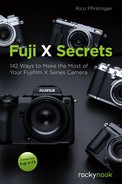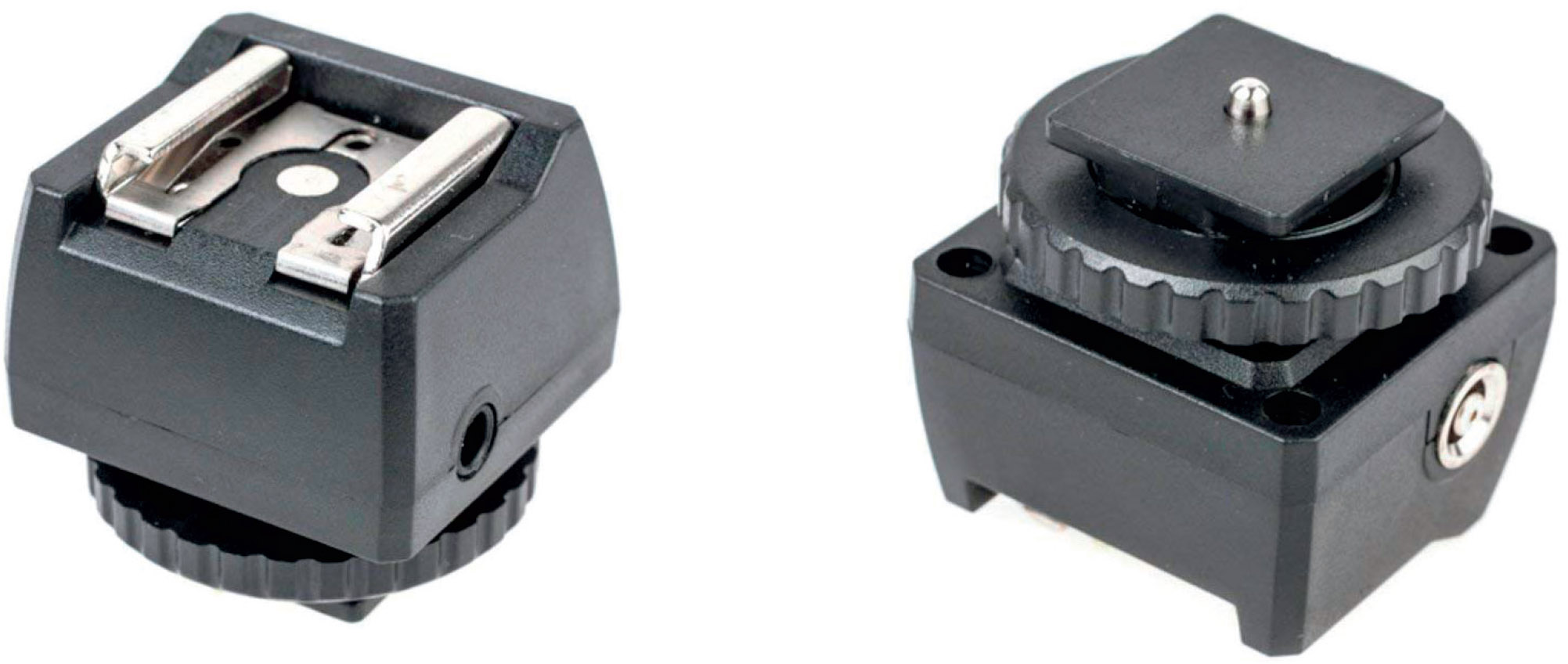1.3 THE BASICS (3): USEFUL ACCESSORIES
There’s a rich selection of accessories for X series cameras. I’ll cover a few select items that can, in my opinion and experience, improve the functionality of your camera.
Optional handgrips |
An optional handgrip can improve the ergonomics of your camera when you are using heavy lenses or if you have large hands.
Fujifilm offers handgrips for many X series cameras that provide full access to the battery compartment and are compatible with Arca-Swiss-type tripod heads, so you don’t need a dedicated quick release plate. The handgrip is the quick release plate.
Fig. 61: The optional handgrip MHG-XT10 provides direct access to the battery compartment of the X-T10 and X-T20 and can be mounted on an Arca-Swiss-type tripod head. Similar grips are available for the X-T1, X-T2, X-T3, X-Pro2, X-E3, X-E2(S), and X100T.
A Vertical Power (Booster) Grip is another useful option to enhance both the ergonomics and the performance of your X-T1, X-T2, X-T3, X-H1, or GFX 50 S. Vertical power grips can fit one or two additional batteries to increase the maximum number of shots per charge.
For improved upright shooting, vertical power grips mirror many of the respective camera body’s controls. The tripod-mounting socket is aligned with the camera’s optical axis, and the grip is resistant to dust and water. Vertical grips for the X-T2, X-T3, X-H1 and GFX 50S also offer their own direct battery-charging functionality via an external power supply.
The Vertical Power Grips for the X-T2 and X-H1 are actually Vertical Power Booster Grips, since they both feature a dedicated Boost mode switch that improves AF speed and the EVF refresh rate. When fitted with the grip, these cameras can use multiple batteries simultaneously to improve performance on aspects such as 4K video recording, continuous shooting, shooting interval, shutter release time lag, and blackout time.
Fig. 62: A Vertical Power Booster Grip is a useful companion for the X-T2 and X-H1. Personally, I almost never take it off. It enhances the camera’s usability with large and heavy lenses, offers improved ergonomics for vertical shooting, and features a headphone output for videographers. Its most important features are the addition of up to two batteries and its performance-boosting capabilities. With a total of three batteries in the camera body and the grip, users can spend a day of intense shooting without changing or charging batteries. When they are empty, the two extra batteries can be simultaneously recharged in the grip with an external power supply.
The GFX 50S and the new X-T3 can achieve their maximum performance without adding vertical power grips.
Off-camera TTL flash with a Canon OC-E3 TTL extension cord |
X series cameras with a hot shoe can be combined with most third-party flashes, as long as the flash output is controlled manually. However, Fuji’s automated TTL flash exposure only works with Fujifilm compatible TTL flash units like the EF-20, EF-X20, and EF-42, or the great Metz M400. In late 2016, Fujifilm also added the professional EF-X500 flash unit to the lineup. The EF-X500 allows wireless TTL and FP high-speed-sync (HSS).
TTL is an abbreviation for “Through The Lens,” which means that the camera determines the appropriate flash output by measuring a scene through the lens with a weak pre-flash. To work in TTL mode, compatible flash units must be connected with the camera’s hot shoe, and strangely enough, there’s still no Fujifilm-branded TTL extension cable on the market that allows you to use a TTL flash off-camera.
A simple solution for this dilemma is using a Canon OC-E3 extension cable, which is pin-compatible with Fuji’s flash contacts. With such a cable (or an equivalent third-party product), it is possible to use an EF-20, EF-X20, EF-42, EF-X500, or any other Fuji TTL-compatible flash off-camera in TTL mode.
Please note that Canon OC-E3 cables are only compatible with Fuji’s TTL flash connectors, not with Fuji’s TTL flash protocol. This means that it isn’t possible to use Canon TTL flash devices with your X camera in TTL mode.
Fujifilm’s compact (and retro-styled) EF-X20 flash features an optical slave mode and can be wirelessly triggered by another flash unit. However, this is no automated TTL mode, so the output of the EF-X20 must be manually controlled while in slave mode.
Fig. 63: A Canon-compatible TTL extension cord also works with Fujifilm X series cameras.
Possible issues regarding Canon TTL flash devices |
When Fujifilm introduced its previous generation of X cameras with the X-Pro2 in early 2016, using Canon-compatible flash devices (e.g., flash units or radio transmitters) on the hot shoe sometimes led to an overload of the camera’s processor, which resulted in overheating (you’d see overheating warnings if this happened). It was caused by incompatible Canon/Fuji TTL flash protocols that are routed through compatible flash contacts, as described in the previous tip.
After several firmware upgrades, it’s unlikely that this issue still persists. However, if it does, it can even occur when you are using your Canon-compatible flash gear in full manual mode without any expectation of TTL exposure control. You may only want a simple trigger signal, but what you get are colliding protocols with adverse side effects.
Should you encounter these problems with your gear, you have three basic choices:
- Stop using your Canon-compatible TTL flash or transmitter and replace it with simpler devices that only use a central trigger contact.
- Tape the TTL contacts of your flash devices, leaving only the central trigger contact. This ensures that the only electric connection between the camera and the flash or transmitter is the flash trigger contact.
- Use an adapter that isolates the flash sync signal and blocks all other hot shoe pin connections to your flash device. This is like taping TTL pins, just more convenient. Suitable adapters are available for only a few dollars.
Fig. 64: Do you experience overheating warnings after connecting incompatible TTL flash units to your Fuji X camera? A cheap and simple mid-contact hot shoe adapter separates the trigger signal from undesirable TTL signals.
Please note that flawless flash operation is only guaranteed when you use devices that explicitly support the Fujifilm X flash system and protocol. Alternatively, you can also use simple, manual flash devices and transmitters that only use the camera’s central trigger contact. Other flash devices (that were originally made for other camera brands and systems) may also work in full manual mode, but there’s no guarantee for it. Proceed at your own risk.
Remote shutter release option |
From time to time you may encounter situations that require you to remotely release the shutter without vibration. A quick-and-dirty method is to use the camera’s self-timer with a delay of either two or ten seconds, although a better way is using a remote shutter release. Most X cameras offer at least two of the following three port options to connect remote shutter releases:
- Some X cameras (especially the retro-branded ones) feature a mechanical thread in the shutter button that allows you to screw in a traditional mechanical cable release.
- Most models include either an RR-80 (Mini-USB, older cameras) or RR-90 (Micro-USB, more recent models) port that is compatible with a variety of electronic remote controls.
- You can connect Canon-compatible electronic remote shutter releases to the Mic/remote release port (a 2.5mm socket that exists in most X series cameras). Fujifilm is also now selling a Canon-style remote named RR-100.
Electronic shutter releases are available in tethered and wireless versions. Wireless options always consist of a transmitter and a receiver. The transmitter sends a trigger signal that is picked up by the receiver, which triggers the camera with an electronic cable that’s connected to the RR-80, RR-90, or 2.5mm remote release port (RR-100).
Fujifilm offers basic RR-80, RR-90, and RR-100 (Canonstyle) shutter release cables, but there are more sophisticated (both tethered and wireless) solutions from third parties, such as programmable intervalometers.
Fig. 65: Fujifilm’s RR-90 is a simple and reliable remote for most X camera models.
If you already own an older RR-80-type shutter release (which was the standard for the X-E1), you can buy a third-party adapter cable that lets you use RR-80 remote shutter releases with RR-90 cameras. Please note that a simple USB-Mini to USB-Micro adapter doesn’t work; you have to ask for a dedicated RR-80 to RR-90 adapter.
The 2.5mm remote release port (RR-100) is compatible with a widely used Canon remote shutter release standard. Among others, it is compatible to the following camera models: Canon EOS Digital Rebel, Canon EOS 1000D, Canon EOS 100D, Canon EOS 1100D, Canon EOS 300D, Canon EOS 350D, Canon EOS 400D, Canon EOS 450D, Canon EOS 500D, Canon EOS 550D, Canon EOS 600D, Canon EOS 60D, Canon EOS 60Da, Canon EOS 650D, Canon EOS 700D, Canon EOS Kiss Digital, Canon EOS Kiss F, Canon EOS Kiss Digital N, Canon EOS Kiss X2, Canon EOS Kiss X3, Canon EOS Kiss X4, Canon EOS Kiss X5, Canon EOS Kiss X50, Canon EOS Kiss X6i, Canon PowerShot G1 X, Canon PowerShot G10, Canon PowerShot G11, Canon PowerShot G12, Canon PowerShot G15, Canon PowerShot SX50 HS, Canon EOS Rebel SL1, Canon EOS Rebel T1i, Canon EOS Rebel 70 T2i, Canon EOS Rebel T3, Canon EOS Rebel T3i, Canon EOS Rebel T4i, Canon EOS Rebel XS, Canon EOS Rebel XSi, Canon EOS Rebel XT, Canon EOS Rebel XTi, Canon EOS Rebel T5i, Contax 645, Contax N, Contax N Digital, Contax N1, Contax NX, Hasselblad H1, Hasselblad H3D, Hasselblad H4D-200MS, Hasselblad H4D-31, Hasselblad H4D-40, Hasselblad H4D-50, Hasselblad H4D-50MS, Hasselblad H4D-60, Pentax 645D, Pentax *ist D, Pentax *ist DL, Pentax *ist DL2, Pentax *ist DS, Pentax *ist DS2, Pentax K-30, Pentax K-5, Pentax K-7, Pentax K-m, Pentax K10 Grand Prix, Pentax K100D, Pentax K100D Super, Pentax K10D, Pentax K110D, Pentax K200D, Pentax K20D, Pentax MZ-6, Pentax MZ-L, Pentax ZX-L, Samsung GX-1L, Samsung GX-1S, Samsung GX-20, Samsung NX10, Samsung NX100, Samsung NX11, Samsung NX5, Sigma SD1, Sigma SD1 Merrill, and Sigma SD15.
This list isn’t complete, but it’s a pretty good start. Remote shutter releases that are compatible with any of these listed cameras should also work with your X camera, as long as it features a 2.5mm remote release port.
Personally, I’m a big fan of Canon’s simple yet effective RS-60E3 electronic remote shutter release. It’s small and affordable, and it shines with a nice attention to detail.
Fig. 66: The Canon RS-60E3 is my favorite electronic cable release for Fujifilm X cameras—thanks to its attention to detail. For example, the 90-degree angle of the plug ensures that the release can be used in concert with L brackets when the camera is sitting upright on a tripod. Also, two carvings make it easy to neatly spool the cable around the release after shooting. Finally, there’s a built-in socket for the 2.5mm plug that prevents the cable from unspooling in the bag.
Alternatively, you can remotely control Wi-Fi-enabled X cameras with the free Fujifilm Camera Remote app [29] for iOS or Android devices. Step-by-step instructions are available online [30].
If you own an X camera with Bluetooth, you can use that semi-permanent connection to your smartphone or tablet to remotely release the shutter [31].






